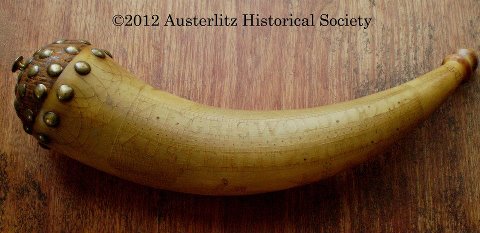The April AHS Board of Trustees meeting was winding down when Bob Herron mentioned a call he received about a fine 19th century powder horn with Austerlitz inscribed on it. It had been in an important show and was for sale. Were we interested? That got us on the edge of our seats.
We already have a selection of 1830’s period items, but very few are actually from Austerlitz. As families died out or moved, their possessions were often divvied up or sold, and scattered across the country. Part of our Society mission is to collect and preserve artifacts from Austerlitz, and the powder horn could be used in education programs, another part of our mission. We decided to act quickly to add it to our collection before it was sold to someone else.

Powder horns were very important to our early residents. They were the container for black powder (a mixture of sulphur, charcoal, and potassium nitrate or saltpeter) which was used as the propellant in firearms of the period. A good basic powder horn had to be a convenient size for a person to carry and might hold about a pound of powder. If the powder got damp or wet it would not ignite, so the powder horn had to be rain proof and sealed so it could be dunked in water while fording a stream or if a boat overturned.
They were most often made from cattle or buffalo horn. These horns are sheaths that fit over the protrusions of bone from the animal’s head and have a network of material inside called pith, which was scraped out. After cleaning, a horn was dried and cured. The end of the narrow tip was cut off and a hole was drilled into the hollow part of the horn so the powder could be poured out. Then the area before the tip was sanded down, leaving a raised ridge of horn where the sling could be secured. The wider end of the horn is the butt, and this was trimmed so a plug, usually of wood, could be inserted. The plug was sealed into the butt to make it watertight and provided a place for a ring or fastener used to secure the other end of the shoulder sling.
This was the basic, functional powder horn. From there they could be embellished with carvings, names, figures, dates, designs, and non-ferrous metals (iron can cause sparks and ignite the powder.) They are classified as folk art, and vary according to the skill of the maker. Some artisans were exceptionally talented and might be commissioned to make a powder horn rather than it being made by the owner.
Our powder horn is inscribed with Austerlitz, June 24, 1825 and the name N. F. Griswold, with the “N” facing backward. He was Norman Francis Griswold, born in Spencertown on May 15, 1805, to Jabez and Anna Spencer Griswold. He was about 20 years old when the horn was made, and we do not know the significance of the June 24 date or whether he made the horn himself. In 1827 he married Deborah Richmond in Chatham and remained there throughout his life. According to census records, Norman and Deborah had four sons (George, Norman Delmar, Crawford and Stephen) and three daughters (Julia, Cynthia, and Phebe). At least two of their sons, George and Crawford, registered for the Civil War. George appears to have moved to Illinois, Norman Delmar to Ohio, and Crawford to Indiana.
Norman made his living as a merchant and died in 1873. It is interesting that Norman Francis was the younger brother of Sherman Griswold, the subject with his wife, Lydia Dean, of the well-known painting “Salting the Sheep” (painted by James E. Johnson) which is in the possession of the Columbia County Historical Society.
The powder horn is about 11 inches long and on the smallish size of the 12 inch+ length of most powder horns. The quality of workmanship and carving makes up for its size. It is beautiful. There are figures of birds (probably a swan and eagles), a ship, a steamboat, stars, a whale, possibly a castle, and a pine tree. The tip has a raised ridge of horn made to hold the shoulder sling. The butt end has a protruding, rounded wooden plug studded with brass tacks, and a brass knob for attachment. There are more tacks through the horn, possibly to hold the plug securely in place. Grasped with the tip end down, it looks like an ice cream cone sprinkled with brass M&M’s. The overall color is light yellowish and brown. The usual technique was to stain the whole horn with something like butternut, then add a darker stain rubbed into the carving to fill in the lines and make them stand out.
This is an outstanding artifact to add to our collection at Old Austerlitz. As usual, Bob Herron has come through for the Society, and we appreciate his years of experience in the antiques world and the contacts that brought this opportunity to us.
